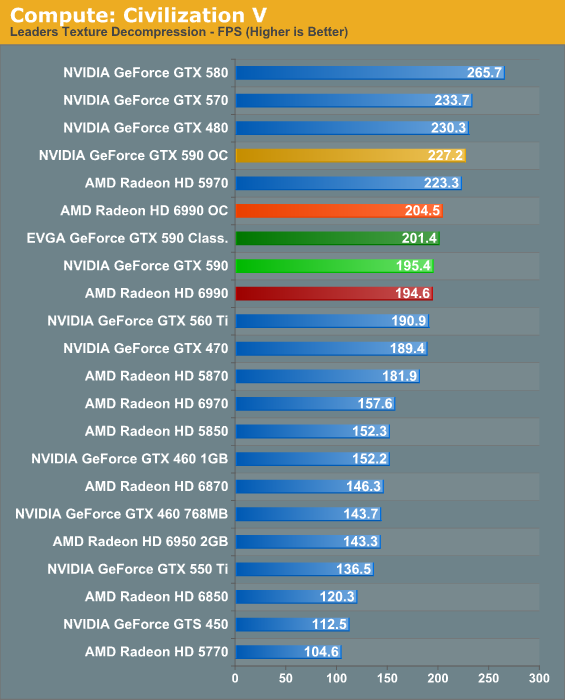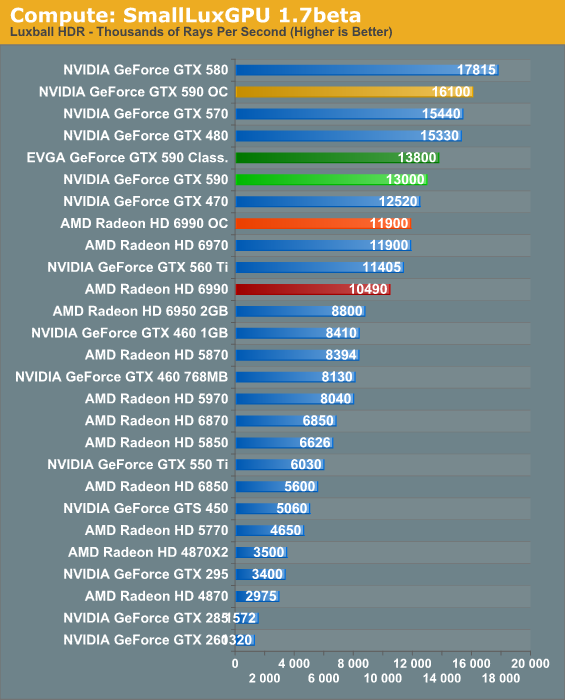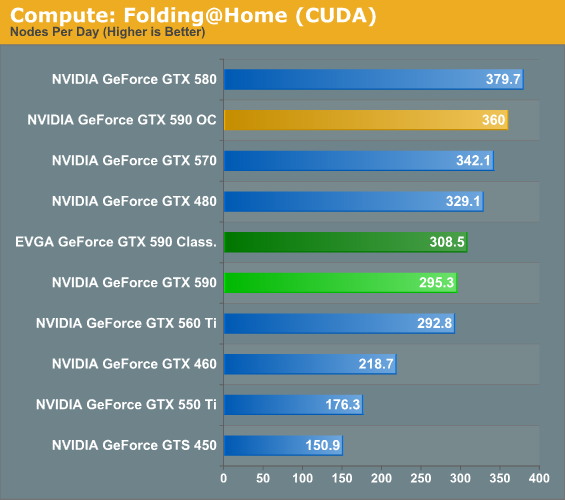NVIDIA’s GeForce GTX 590: Duking It Out For The Single Card King
by Ryan Smith on March 24, 2011 9:00 AM ESTCompute
Moving on from our look at gaming performance, we have our customary look at compute performance.
Our first compute benchmark comes from Civilization V, which uses DirectCompute to decompress textures on the fly. Civ5 includes a sub-benchmark that exclusively tests the speed of their texture decompression algorithm by repeatedly decompressing the textures required for one of the game’s leader scenes.

In the game world Civ5 benefits significantly from SLI and CrossFire. For our texture compression test however AFR is more a liability than a benefit. This doesn’t impact the game in any meaningful manner, but it’s an example of how SLI/CF aren’t always the right tool for the job. Unfortunately for both parties, with as few compute applications as there are today, almost none of them benefit from SLI/CF.
Our second GPU compute benchmark is SmallLuxGPU, the GPU ray tracing branch of the open source LuxRender renderer. While it’s still in beta, SmallLuxGPU recently hit a milestone by implementing a complete ray tracing engine in OpenCL, allowing them to fully offload the process to the GPU. It’s this ray tracing engine we’re testing.

SmallLuxGPU only currently supports ray tracing with one GPU, so all of our results are effectively proxies for what would be if the GTX 590 only had one GPU. Not surprisingly overclocks do wonders here, and NVIDIA’s strong compute architecture gives them an easy win. SLI/CF performance will become more important here when we upgrade to LuxMark for our next iteration of our benchmark suite, as LuxMark can handle multiple OpenCL drivers.
Our final compute benchmark is a Folding @ Home benchmark. Given NVIDIA’s focus on compute for Fermi, cards such as the GTX 590 can be particularly interesting for distributed computing enthusiasts, as two GPUs should be able to quickly retire work units.

Folding@Home doesn’t directly benefit from CF/SLI at all. However by dispatching one WU to each GPU it’s possible to double effective performance. With that taken into account the GTX 590 is quite an effective cruncher, particularly when we start looking at overclocking.










123 Comments
View All Comments
valenti - Thursday, March 24, 2011 - link
Ryan, I commented last week on the 550 review. Just to echo that comment here: how are you getting the "nodes per day" numbers? Have you considered switching to a points per day metric? Very few people can explain what nodes per day are, and they aren't a very good measure for real world folding performance.(also, it seems like you should double the number for this review, since I'm guessing it was just ignoring the second GPU)
Ryan Smith - Thursday, March 24, 2011 - link
Last year NVIDIA worked with the F@H group to provide a special version of the client for benchmark purposes. Nodes per day is how the client reports its results. Since points are arbitrary based on how the F@H group is scoring things, I can't really make a conversion.poohbear - Thursday, March 24, 2011 - link
Good to see that a $700 finally has a decent cooler! Why would somebody spend $700 & then go and hafta spend another $40 for an aftermarket cooler??? nvidia & AMD really need to just charge $750 and hve an ultra quiet card, these people in this price range are'nt gonna squabble over an extra $50 for petes sake!!!! it makes no sense that they skimp on the cooler at this price range! this is the top of the line where money isnt the issue!Guspaz - Thursday, March 24, 2011 - link
Let's get this straight, nVidia. Slapping two of your existing GPUs together does not make this a "next-generation card". Saying that you've been working on it for two years is also misleading; I doubt it took two years just to lay out the PCB to get two GPUs on a single board.SLI and Crossfire still feel like kludges. Take Crysis 2 for example. The game comes out, and I try to play it on my 295. It runs, but only on one GPU. So I go looking online; it turns out that there's an SLI profile update for the game, but only for the latest beta drivers. If you install those drivers *and* the profile update, you'll get the speed boost, but also various graphical corruption issues involving flickering of certain types of effects (that seem universal rather than isolated).
After two goes at SLI (first dual 285s, next a 295), I've come to the conclusion that SLI is just not worth the headache. You'll end up dealing with constant compatibility issues.
strikeback03 - Thursday, March 24, 2011 - link
And that is why people still buy the 6970/580, rather than having 2 cheaper cards in SLI like so many recommend.JarredWalton - Thursday, March 24, 2011 - link
For the record, I've had three goes at CrossFire (2 x 3870, 4870X2, and now 2 x 5850). I'm equally disappointed with day-of-release gaming results. But, if you stick to titles that are 2-3 months old, it's a lot better. (Yeah, spend $600 on GPUs just so you can wait two months after a game release before buying....)Guspaz - Friday, March 25, 2011 - link
I don't know about that, the original Crysis still has a lot of issues with SLI.Nentor - Thursday, March 24, 2011 - link
"For the GTX 590 launch, NVIDIA once again sampled partner cards rather than sampling reference cards directly to the press. Even with this, all of the cards launching today are more-or-less reference with a few cosmetic changes, so everything we’re describing here applies to all other GTX 590 cards unless otherwise noted.With that out of the way, the card we were sampled is the EVGA GeForce GTX 590 Classified, a premium GTX 590 offering from EVGA. The important difference from the reference GTX 590 is that GTX 590 Classified ships at slightly higher clocks—630/864 vs. 607/853.5—and comes with a premium package, which we will get into later. The GTX 590 Classified also commands a premium price of $729."
Are we calling overclocked cards "more-or-less reference" cards now? That's a nice way to put it, I'll use it the next time I get stopped by a police officer. Sir, I was going more or less 100mph.
Reference is ONE THING. It is the basis and does not waver. Anything that is not it is either overclocked or underclocked.
strikeback03 - Thursday, March 24, 2011 - link
Bad example, as in the US at least your speedometer is only required to be accurate within 10%, meaning you can't get ticketed at less than 10% over the speed limit. This card is only overclocked by 4%. More importantly, they a) weren't sent a reference card, and b) included full tests at stock clocks. Would you rather they not review it since it isn't a reference card?Nentor - Thursday, March 24, 2011 - link
That is a good point actually, I didn't think of that.Maybe reject the card yes, but that is not going to happen. Nvidia is just showing who is boss by sending a non reference card. AT will have to swallow whatever Nvidia feeds them if they want to keep bringing the news.